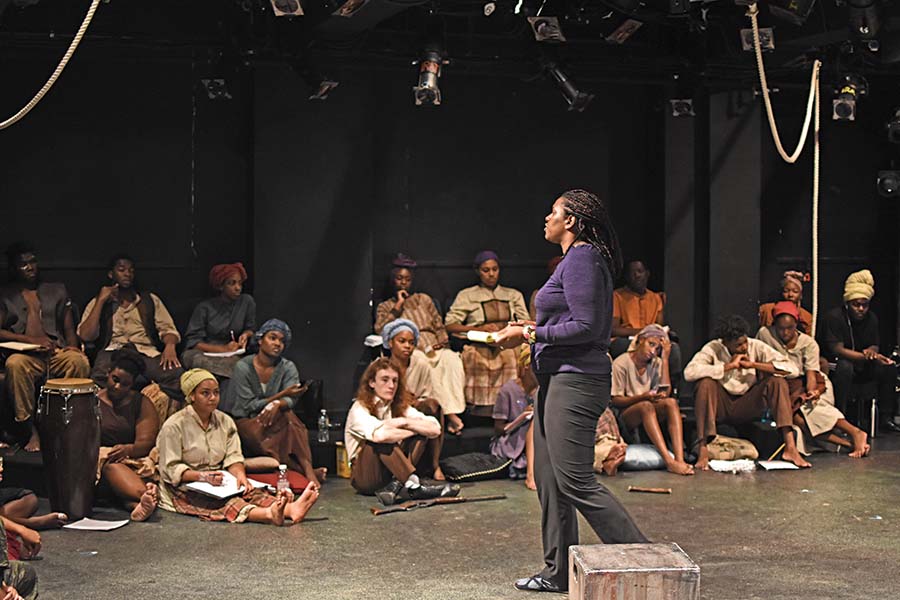By now most of us have a basic grasp of the case for diversifying our theatres. The most anodyne form of the argument goes like this: Our stages and offices still don’t reflect our changed and changing America, which will be majority non-white in by 2045 (and is already way past that point in most of the urban centers where many theatres are located). The stronger argument, not mutually exclusive with the first: Our theatres are built on and reinforce colonialist systems of oppression that have excluded and silenced women, people of color, LGBTQ people, and disabled people. Either way you frame it, it’s a systemic problem, and nothing less than systemic, root-and-branch solution will suffice.
One deep root that could use some pulling, pruning, or replanting is the way theatre artists are trained—not only which plays are taught as essential or “canonical,” but also which theatre techniques are inculcated into new generations of artists. These questions and their answers cut to the heart not only of what theatre training is and can be, but who it’s for. What good is it to diversify the theatre’s personnel, but still teach them the same old plays and techniques? I spoke to folks who are doing something different and encouraging others to blow up the canon as well. Here are some takeaways.
Method madness. Monica White Ndounou, associate professor of theatre at Dartmouth and founder of a nonprofit called the CRAFT Institute, has made diversifying acting training one of her main areas of study, teaching, and activism. Pointing to a study by Susan Nolen-Hoeksema that looked at the disproportionately adverse effects of “ruminating” on negative events for women, Ndounou questions Method-based emotional memory techniques, which still underpin much mainstream acting training. What are some alternatives? Ndounou cites black theatre pioneers like Barbara Ann Teer, who founded the National Black Theatre, and Ernie McClintock, who taught “jazz actors’ technique” at his studio in Harlem. Unlike Method-based emotional memory, African American cultural and historical consciousness, she says, is “not baggage that is going to prevent the actor from being able to perform; it’s rich material to draw from in creating characters in performance.” Scott Proudfit, a professor of English at Elon University who has studied female-created collective theatre models, cites such strong alternative traditions as Anne Bogart’s SITI Company, the Suzuki method, and Viola Spolin’s improvisational approach.
Culture, not race. Though her focus has been on “the enormous contributions of black Americans” that don’t get included in formal training, Ndounou wants to see other cultural traditions represented as well, the better to help students of various backgrounds answer the question, “How can I bring my own self into my work?” The goal is to “understand people in terms of culture, not race. Race is superficial; it was invented. Culture is how people live: what they eat, what they wear, the music they create. When you share culture across real and artificial boundaries—that’s what we do as artists. As long as we’re only operating with race as the guidepost—that’s where the stereotypes live. When you get with culture, that’s where the people are.”
Mix it up. Nicole Brewer, who offers conscientious theatre training and heads up the Cross-Cultural Collaborative Committee, often hears from institutions who feel they’d be “doing a disservice if they did not teach Chekhov and Shakespeare.” She responds with a formula: “For every white piece of theatre, teach three that are by people of color, or of differing abilities.” Ndounou has a more radical suggestion: “What if you did five years of seasons of only women, people of color, and trans artists? For an actual real revolution, go completely rogue and do all of the work that gets pushed into the diversity slot, and put the canonical work in that diversity slot.” For those who balk at the sweep of this notion, and reflexively worry about performance opportunities for white students, Ndounou responds, “No one has been asking that question about students of color. Instead they wonder, how could we go out of our way to accommodate the white students? Well, what if we had that same kind of passionate concern about people who aren’t represented?”
Reality check. If education is meant to prepare students for the real world, all the more reason for a wider-ranging training menu. American theatre may not have full gender parity or embrace a full rainbow of diversity, but this is not the 1950s, or even the 1990s, anymore. Charles McNulty, drama critic for the Los Angeles Times, who teaches a class at CalArts called “American Drama Now,” says, “It’s just a simple fact that the best playwriting in America is being produced by writers from a variety of backgrounds. Straight white men are the minority in my course.” Proudfit counter-programs Elon’s fairly conservative student seasons with a new-play reading series of works by the likes of Young Jean Lee, Qui Nguyen, and Martyna Majok. “These are not marginal works,” Proudfit says. “Because of repertory, the classics aren’t going away–we’re not going to stop teaching Shakespeare. But ultimately more diverse training is more accurate to the professional world they’re going into.”


